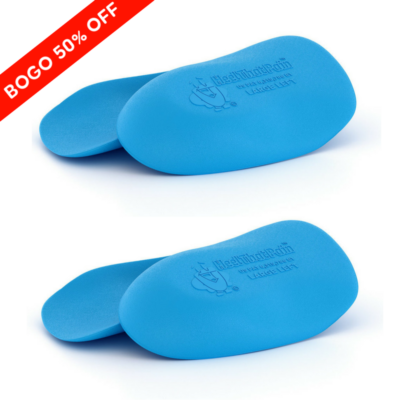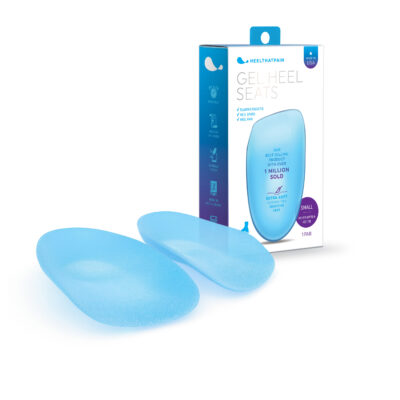Foot, Heel, and Arch Injuries: An Overview
Take a moment to consider just how many hours you spend standing or walking every day — not to mention the periodic stress of running, playing sports, or exercising!
Most of the time, our marvelous feet, heels, and arches perform these tasks flawlessly. However, the combination of daily wear, impact, aging, and unexpected obstacles make the human foot vulnerable to a wide variety of injuries.
Learning about the most common kinds of foot, arch, and heel injuries can help you quickly identify the problem, seek proper treatment, and avoid long-term damage.
Plantar Fascia Injuries
Dealing with pain along the arch of your foot or on the bottom of your heel? You may have injured the main ligament in your foot – the plantar fascia. This strong, elastic ligament spans the bottom of your foot from the heel bone to the ball. It’s designed to allow you to flex your feet and it supports the spring in your step as you walk.
Plantar Fasciitis
Plantar fasciitis is one of the most common foot injuries, affecting more than one in ten people over the course of a lifetime!
Why is it so common? The arch of the foot or plantar fascia is a little like a rubber band, stretching and flexing with every step we take to bear and distribute weight and impact. With overuse, strain, and injury, this flexible band of tissue can sustain small tears and begin to deteriorate, get weaker, or wear out. Plantar fasciitis can be caused by sudden weight gain, an uneven gait that puts extra strain on your arch, high-impact sports, the normal aging process that decreases elasticity of your ligaments, or just poorly fitting shoes.
Symptoms of plantar fasciitis include redness and swelling, heel pain (particularly morning heel pain) and pain that improves somewhat with walking or other moderate activity. Most cases of Plantar Fasciitis can be resolved with conservative treatments like rest, icing, heel stretches, and Fascia-Bar orthotic treatments. It’s also important to note that plantar fasciitis is also extremely common in individuals without any sort of trauma or injury to the foot.
Plantar Fascia Rupture
Unlike plantar fasciitis, which typically develops more gradually (over a few days, weeks, months, or even years) a rupture in the plantar fascia ligament is generally more dramatic and intensely painful. A rupture of the plantar fascia involves a large tear and partial destruction of the plantar fascia ligament.
Athletes who participate in high-impact sports are especially prone to this injury and often report hearing a “popping” sound at the time of injury. If you feel sudden, extreme pain in the heel and arch of your foot, stop what you’re doing, and seek medical attention immediately; you may have sustained a plantar rupture. may indicate a rupture. The healing process from this type of plantar fascia injury typically revolves around rest, the use of a walking boot, and support with crutches. In some cases, surgery may be needed. Future ruptures can be prevented through the appropriate use of orthotic shoe inserts, such a Heel Seats, wearing properly fitting shoes, and stretching properly before exercise and throughout the week to strengthen the plantar fascia.
Heel Injuries
Heel injuries can develop when the fatty pad protecting the heel bone begins to wear out, become thinner, or flatten and erode. Wearing improper footwear is one of the most notorious causes of common heel injuries like these:
Heel Spurs
Heel spurs are abnormal calcium deposits on the heel bone that often develop alongside plantar fasciitis as the heels’ protective fatty pad wears down through overuse and strain. And while some heel spurs may grow undetected for some time, others begin to prod at the tender tissue cushioning the heel bone, causing extreme pain.
Some podiatrists believe that these bony growths are your body’s attempt to support the plantar fascia ligament that has injured. Wearing orthotic inserts that lift, properly support, and realign the plantar fascia can take painful pressure off heel spurs, and encourage the fatty pad of the heel to regenerate. In some cases, surgery may be required to remove large or very painful heel spurs, but the vast majority (90%) can be resolved at home with orthotics, rest, and supportive footwear.
Sever’s Disease:
Sever’s disease, or calcaneal apophysitis, is a common heel injury in physically active children ages 9-15. Often dismissed as “growing pains,” this serious condition happens when the growth of a child’s heel bones are slower than the other ligaments in the leg. Children’s heel bones reach maturity before the rest of their bodies and can be more prone to injury while the rest of the body plays catch-up.
Sever’s disease is more common in children who play sports on hard surfaces (like a basketball court), stand for long periods of time, or wear unsupportive shoes. Symptoms include pain in the heels, limping, and changes in gait. If your child is complaining of heel pain, see a doctor! He or she will likely recommend rest, icing, orthotic inserts to support the developing heel, and in some cases a walking boot.
Haglund’s Deformity (Pump Bump)
Pump bump, or Haglund’s Deformity, is a bony protrusion that develops at the back of the heel in response to rubbing and irritation (usually from ill-fitting shoes). The condition is especially common in women who wear high heels or “pumps,” although rigid men’s dress shoes can be a culprit too!
Symptoms include a hard bump at the back of the heel, redness, and swelling, and irritation or pain. Over time, if left untreated, Haglund’s Deformity can get progressively larger, leading to gait changes and inflammation of the bursa or fluid-filled sac at the heel joint. Treatment usually involves switching to more supportive, less rigid footwear, icing, and wearing orthotic inserts that gently lift and support the heel and arch.
Bursitis
The retrocalcaneal bursa, or the fluid-filled sac that cushions and protects the tissues connecting your heel and ankle joint, can become irritated and inflamed through overuse, rubbing, and repeated impact.
Bursitis shows up as swelling and inflammation at the back of the heel, redness, and tenderness to the touch, and difficulty standing on tiptoe. The condition is often mistaken for Achilles tendonitis since the symptoms are localized where the Achilles’ tendon meets the heel bone. Treatments typically include rest, icing, stretching, and orthotic inserts to relieve pressure on the arch and heel.
Foot Injuries
The many ligaments, muscles, and bones of the foot are vulnerable to injury during exercise, sports, or everyday use particularly in the absence of proper footwear and support. The following are some of the most common foot injuries:
Sprains and Fractures
A stumble, a blow to the foot, an uneven surface that causes the foot to slip or slide, or even just repeated strain and overuse can lead to injuries of the bones, ligaments, and muscles in the foot and ankle.
Sprains and fractures are two of the most common foot injuries. A sprain involves the stretching or tearing of ligaments in the foot, and is usually treated with plenty of rest, icing, compression with an ace bandage, and sometimes crutches depending on the severity of the strain. While the pain from a sprain may be sudden and sharp, it’s usually possible to place some weight on the hurt foot, which typically improves within one to three days. A fracture, on the other hand, typically causes sharp and shooting pain in the bone when weight is placed on the foot.
If you believe you may have fractured your foot or ankle, it’s important to see a doctor to determine treatment and get your foot examined. Your doctor may recommend a cast or walking boot depending on the location of your fracture.
Ligament Traumas
While a sprain is usually the result of twisting or rotating the ligament, a blow or a sudden injury from stepping on an uneven surface or hard object can result in trauma or a bruise. If you cut the sole of the foot open deeply and are bleeding, seek medical attention, and pay special attention to possible infection. For more minor bruises or cuts, keep the area compressed, clean, and dry while the area heals.
Achilles Tendonitis or Achilles Rupture
Achilles tendonitis is similar to plantar fasciitis and results from tears to the Achilles tendon, which is located where the calf meets the heel. Achilles tendonitis can come on suddenly or over time, with symptoms of pain, swelling, and tenderness at the back of the heel. You may find it more difficult than usual to stand on tiptoe or point your toes.
Achilles tendonitis is usually the result of an overly tight Achilles tendon and can be improved with stretching, icing, rest, and proper warm-up before and after physical activity. It’s extremely important to address Achilles tendonitis since the condition can lead to Achilles rupture if not addressed. In a rupture, the Achilles tendon tears, leading to severe pain and trauma to the ligament. In many cases, surgery may be required to treat a rupture.
Metatarsalgia
Metatarsalgia is the result of inflammation in the metatarsal area, or ball of the foot, where the toes connect to the foot. This condition is typically the result of too much pressure on the forefoot, which is often the result of wearing high-heeled shoes or playing sports that involve a lot of impact with the toes like soccer. Symptoms include pain in the ball of the foot that onsets gradually over time and swelling and redness in the ball of the foot. Treatments usually involve wearing more supportive footwear and resting from the activities causing the pressure on the forefoot.
Tarsal Tunnel Syndrome:
Tarsal tunnel syndrome develops when the tibial nerve — a nerve at the base of the ankle — gets pinched or constricted, creating inflammation, tingling numbness, and soreness. It’s similar to carpal tunnel syndrome, which happens in the wrist as a result of nerve compression.
The tibial nerve can be compressed and irritated through overuse, shoes that press on the base of the ankle, or different movements in sports or exercise. Like most other foot injuries, conservative treatments include rest, switching to more supportive footwear, icing, and NSAIDs that calm inflammation and swelling.
Preventing Foot, Heel, and Arch Injuries
When it comes to foot, heel, and arch injuries, prevention is the name of the game. Keep your feet healthy by using the following best practices to avoid injuries altogether:
- Maintain a healthy weight
- Give yourself enough time to recover between exercise sessions, playing sports, and other kinds of physical activity like walking or standing for long periods
- Pay attention to your body’s pain signals–never ignore them!
- Wear shoes that fit properly and support your foot’s natural position with plenty of padding and structure
- Wear orthotic inserts that help lift and support your arch while you walk or run
- Take special care of your feet in jobs that require heavy lifting or long periods of standing
- Eat a diet rich in vitamins and minerals necessary for supporting ligament health
- Anatomical problems in the feet that cause an irregular walking gait
- Stretch regularly, and always warm up before exercising. Tight ligaments and muscles are ligaments and muscles at risk for injury!
No one wants to be sidelined with an injury. But thankfully, with proper care of your feet, ankles, and arches you can avoid most common foot injuries. If you’ve already developed a condition like Plantar Fasciitis, making lifestyle changes and using proven, conservative treatments like icing, rest, orthotic inserts, and stretching can get you back on your feet quickly!






